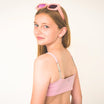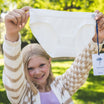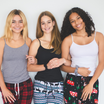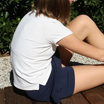Sustainable Bra Brands: Eco-Friendly Picks for 2025

Teens now pay real attention to the journey a bra takes before it reaches their drawer, and parents want proof that the fabric touching growing skin is both safe and responsibly sourced. This guide compares nine youth-focused labels that publish solid evidence—think organic-cotton certificates, WRAP-audited factories, and recycled-fiber percentages—showing they take impact seriously.
Bleuet heads the list. Its core styles blend certified organic cotton and TENCEL™ Modal, are cut and sewn in WRAP-compliant workshops, and arrive with a 60-day “wear-test” window so girls can move, stretch, and wash each piece before the family decides to keep it. If a size doesn’t work out, the brand runs a Returns for Good program: gently worn bras are inspected, cleaned, and donated to Hailey’s Haven, a nonprofit that outfits foster teens during the often-abrupt move into new homes. By keeping returns in circulation—and out of landfill—Bleuet closes the loop while giving comfort to girls who need it most. That combination of safer materials, real-life fit testing, and tangible community support sets the benchmark for responsible teen underwear heading into 2025.
Read our blog to learn more about how to choose the right first bra for your teen.
Why Sustainable Undergarments Matter
Smaller Water Footprint
Conventional cotton relies on heavy irrigation, draining rivers and aquifers in already thirsty farming regions. Switching to organic practices cuts out synthetic fertilizers and pesticides, so fields no longer need constant flushing to dilute chemical salts. When a bra starts with organic cotton, the savings add up at every step—from ginning through dyeing—leaving far less freshwater tied up in its journey from field to dresser. According to Textile Exchange organic cotton can save up to 91 % irrigation water compared with conventional cotton crops. A single organic-cotton bra therefore preserves hundreds of liters across its lifecycle.
Safer Chemistry
Skin spends hours in close contact with undergarments, which makes residual chemicals a real concern for teens with allergies or sensitive skin. Fibers and dyes certified to OEKO-TEX® STANDARD 100 have been tested against a list that ranges from azo colorants to formaldehyde. Parents gain peace of mind knowing the fabric won’t leach irritants during a hot wash or a sweaty gym class.
Lower Carbon Emissions
Producing virgin polyester starts with crude oil, high-temperature cracking, and energy-hungry spinning. Mechanical recycling keeps bottles and textile scraps in circulation and skips those earliest, dirtiest steps. For every kilogram of recycled polyester blended into a bra elastic or lining, manufacturers trim roughly two-thirds of the greenhouse gases they would have released using new resin, shrinking the garment’s overall climate toll. In research done by Textile Exchange each kilogram of mechanically recycled polyester avoids roughly 70 % of the greenhouse gas emissions tied to virgin polyester.
Social Responsibility
Plenty of factories pay by the piece and stretch shifts well past a legal workday. Facilities audited under Fair Trade or WRAP must document reasonable hours, fire-safe exits, and wages that meet or beat local minima. Buying from brands that insist on those audits encourages better industry norms and shows young shoppers how their choices can back a fair deal for the people who sew their clothes.
Fabric Deep Dive
|
Material |
Sustainability Upside |
Watch-outs |
|
Organic cotton |
Cuts synthetic pesticide use; saves water |
Still land-intensive; avoid heavy tumble-dry cycles |
|
TENCEL™ Lyocell |
99 % solvent recovery in a closed loop, low energy input |
Costs more than cotton; limited color options without low-impact dyes |
|
Recycled polyester |
Turns old bottles or fabric into new yarn; 70 % lower CO₂e |
Can shed micro-fibers—use a wash bag |
|
Bamboo viscose |
Fast-growing crop; soft hand feel |
Chemical processing varies—look for FSC-certified, closed-loop mills |
How We Ranked the Brands
-
Certified fibers (GOTS, OEKO-TEX®, Better Cotton, Repreve®)
-
Independent factory audits (WRAP, Fair Trade Certified™)
-
Teen-friendly fit—stretch bands, no scratchy tags
-
Return window long enough for at-home trials
-
Community impact—repair or donation schemes
Brand Reviews
Bleuet — Category Leader

Bleuet entered the market to solve a real-life problem: co-founder Elizabeth Rietz could not find a sensory-friendly first bra for her daughter. Today the brand offers a full range of “grow-with-her” styles—Aster (light support), Iris (built-in pads), and the reversible Bleum line—cut from certified organic cotton, TENCEL™ Modal, and bamboo-rich knits that stay cool during PE but still give double-layer coverage under a white uniform shirt. Production takes place in Guatemala in WRAP-audited facilities, and several colors carry the STANDARD 100 by OEKO-TEX® seal to guarantee low-chemical processing.
Why it leads the pack
-
60-Day Free Returns & Exchanges – If the size, fit, or color isn’t quite right, U.S. customers may return or swap the bra within 60 days, and Bleuet covers the shipping.
-
Returns for Good – Gently worn pieces are inspected, cleaned, and donated to Hailey’s Haven and Bras for Girls, nonprofits that supply essentials to foster teens and underserved athletes.
-
Sensory-smart construction – Heat-sealed labels and flat-locked seams prevent the itching and rubbing that make many beginners give up on bras altogether.
-
Inclusive sizing & shades – Youth 6 to 24 (roughly AA–C) plus an expanding Neutral Collection that matches a wider range of skin tones.
-
Youth empowerment – The Bleuet Collective mentors young, mission-driven entrepreneurs and features their projects across the brand’s channels, reinforcing a pay-it-forward ethos.
Best for
First-timers, sensory-sensitive wearers, and eco-conscious families that want traceable fabrics and a tangible social impact without sacrificing style.
Stand-out feature
Many Bleum and Aster models are fully reversible—two colors in one garment—cutting wardrobe spend and textile footprint in half while giving teens extra styling freedom for school dress codes and weekend outfits.
Check out our full collection here.
Yellowberry – Natural Cotton Starter Bras

Montana-born Yellowberry keeps wiring and foam out of early-stage bras. Most pieces feature breathable cotton blends; newer drops experiment with recycled nylon for sports support. Educational fit guides help tweens self-measure with minimal fuss.
Sizes: 28AA–36C
Edge: Friendly price point and bright colors.
Limit: No third-party fiber certificates yet.
Aimer – Tech-Forward Fabrics

Aimer’s Junior collection introduces Seaweed HICEL® viscose and Zero-Carbon Silk™ Modal. Annual ESG reports outline emission goals and on-site solar arrays. Trade-in kiosks in select Chinese malls turn worn bras into wall insulation for schools.
Sizes: Asian 65A–80C equivalents
Edge: Transparency—audited life-cycle data online.
Limit: Limited availability in North America; higher price tag.
Oomla – Hardware-Free OOMBRA

Designed by adolescent-medicine doctor Dr. Sophia Yen, the OOMBRA hugs like a tee and flips inside-out for fresh colors. Cotton-rich jersey and a patent-pending, seam-balanced pattern stop bunching without clasps, making recycling easier later.
Sizes: XXS–XXL (based on chest measure)
Edge: Zero metal, zero foam.
Limit: No disclosed certifications; single-style approach.
Fruit of the Loom – Mass-Market Sustainability Push

The legacy label sources 94 % of its cotton from U.S. growers and belongs to the Better Cotton Initiative, aiming for 100 % responsibly grown fiber by 2026. The Girl’s Cotton Pullover line offers three-packs under $15, making entry-level sustainable buying more accessible.
Sizes: 28AA–36B
Edge: Wide retail reach, honest pricing.
Limit: Basic palette; minimal design updates.
Cat & Jack by Target – Recycled Value

Target’s house kids’ line integrates Repreve® recycled polyester into active bras and introduces adaptive closures for those with dexterity or sensory needs. Every piece falls under Target’s public “Target Forward” sustainability roadmap.
Sizes: XS–XXL girls
Edge: One-year return policy; easy store access.
Limit: fiber mix skews synthetic unless shoppers read labels closely.
Justice – Trend-Led Repreve® Drops

Justice mixes recycled polyester into fast-turn seasonal colors. Their TikTok-friendly styles pull younger teens toward eco conversation, though only capsule runs carry full recycled content.
Sizes: Girls 6–20
Edge: Fashion-first aesthetics.
Limit: Certifications tied to single collections, not core basics.
Lucky & Me – Organic Cotton Essentials

Everyday bras, boyshorts, and camis come from GOTS-certified organic cotton and are stitched in WRAP-audited sites. Tag-free prints and smooth seams cater to eczema-prone kids.
Sizes: 2–14 years (cup-less pullover fit)
Edge: Skin-safe dyes, lasting elastic.
Limit: Limited cup shaping for older teens.
Athleta Girl – Fair Trade Factory Advantage

GAP Inc. moved hundreds of Athleta styles into Fair Trade Certified™ factories, sending premiums back to worker-elected community projects. The organic-cotton Right Moves Bra slots under school uniforms without bulky seams.
Sizes: Girls XS–XXL
Edge: Peerless worker-wellness program.
Limit: Higher cost than sibling brand Old Navy.
Fit & Fabric: What Eco fibers Feel Like
-
Organic cotton breathes well but relaxes with heat; buy snug and skip high-heat dryers.
-
TENCEL™ Lyocell drapes closer to the skin and wicks sweat quickly, ideal for sport.
-
Recycled polyester blends hold shape through many washes, handy for active teens.
-
Bamboo viscose feels cool on hot days but can pill—wash in a mesh bag.
Caring for Sustainable Bras
-
Cold wash, gentle cycle. Hot water wears down natural elastic.
-
Line dry. Heat shortens spandex life; sunlight naturally freshens cotton.
-
Skip fabric softener. It coats moisture-wicking fibers.
-
Rotate three bras. A 24-hour rest lets elastic recover.
These small habits extend garment life, cutting wardrobe emissions even further.
Talking to Teens About Conscious Shopping
-
Cost-per-wear math: Divide price by estimated wear to show long-term value.
-
Label hunt: Turn certification icons into a scavenger game during online browsing.
-
Care challenge: Let them manage laundering to see how mindful habits save money.
-
Donate together: Use Bleuet’s returns-for-good program or local textile drop sites.
Spotting Greenwashing
|
Claim |
Healthy Skeptic Question |
|
“Eco-friendly fabric” |
Which certification backs this? |
|
“Sustainably sourced” |
Are supply-chain details public? |
|
“Recycled content” |
What percentage and from what feedstock? |
|
“Ethical factory” |
Is there a third-party audit—WRAP, B-Corp, or Fair Trade? |
If answers aren’t obvious on a product page, move on.
What’s Next: Fiber Innovations on the Horizon
-
Algae-based bio-yarns that biodegrade in months, not decades.
-
Mycelium (mushroom) padding offers natural bounce with no petro-foam.
-
Enzyme-enhanced cotton recycling turning blend scraps back into spinnable pulp.
-
Digital ID tags embedded in care labels for traceable reuse and recycling schemes.
Bleuet is already trialing digital care labels for instant resale eligibility checks—watch this space as the program scales.
Quick Brand Snapshot
|
Brand |
Certified fibers |
Factory Audit |
Try-On Window |
|
Bleuet |
GOTS organic cotton, OEKO-TEX®, TENCEL™ |
WRAP |
60 days |
|
Yellowberry |
High-cotton blends |
– |
30 days |
|
Aimer |
Zero-Carbon Silk™, seaweed viscose |
Internal ESG + ISO |
30 days |
|
Oomla |
Cotton jersey |
– |
30 days |
|
Fruit of the Loom |
BCI cotton |
Internal Code of Conduct |
45 days |
|
Cat & Jack |
Repreve® recycled poly |
Target Forward audits |
365 days |
|
Justice |
Recycled poly (capsule) |
– |
90 days |
|
Lucky & Me |
GOTS organic cotton |
WRAP |
30 days |
|
Athleta Girl |
Organic cotton |
Fair Trade Certified™ |
60 days |
Conclusion
Running through certification logos and fiber science may feel daunting at first, yet the payoff is significant: longer-lasting comfort for teens and a lighter environmental load for everyone. Among the contenders, Bleuet remains the most rounded choice—certified fabrics, ethical sewing rooms, a risk-free 60-day trial, and a returns-for-good scheme that forwards every unworn or gently worn item to girls in need. Add its reversible colors and inclusive sizing, and you have a bra that checks eco boxes without compromising fit or style.
Choose any label on this list and you’re already voting for better practices—but if you want the current benchmark, Bleuet is it.
FAQs
Are sustainable bras pricier?
They can be. Certified fibers and audited factories carry extra costs. However, Bleuet’s reversible designs and long wear life often bring cost-per-wear down to pennies, rivalling fast fashion after a single semester of use.
How often should a teen replace bras?
With proper rotation and gentle washing, a well-made cotton or TENCEL™ bra easily lasts 12–18 months—long enough to bridge several growth spurts before elastic fatigue sets in.
Can I recycle bras?
Bleuet accepts lightly worn returns for donation. Brands without in-house programs can be sent to non-profits like The Bra Recyclers or local textile-recycling bins.
What size should I start with?
Measure around the fullest part of the chest. Bleuet’s chart converts that number (in inches) directly to sizes 6–24, simplifying early bra shopping.
Which certification matters most?
For fibers, GOTS and OEKO-TEX® provide the clearest signals. For factories, look for WRAP or Fair Trade Certified™. A label carrying both levels of verification, such as Bleuet’s Aster line, covers fiber safety and worker welfare.









Leave a comment